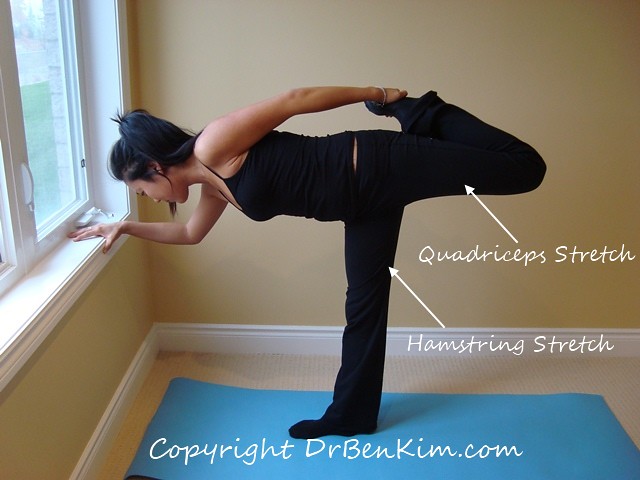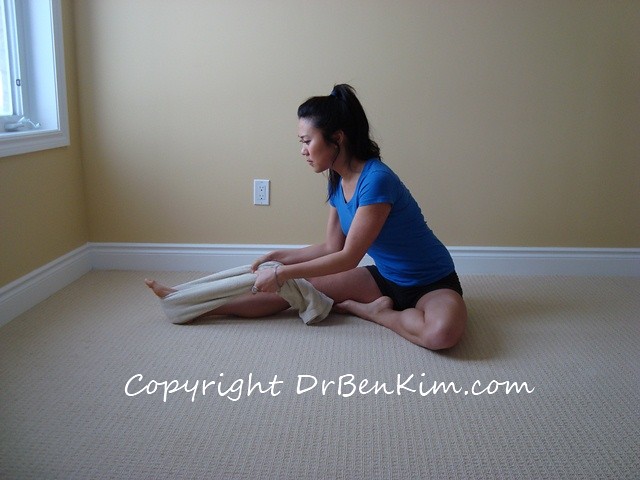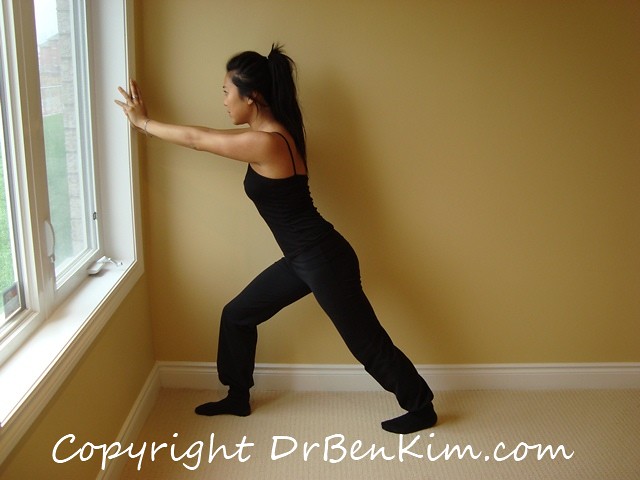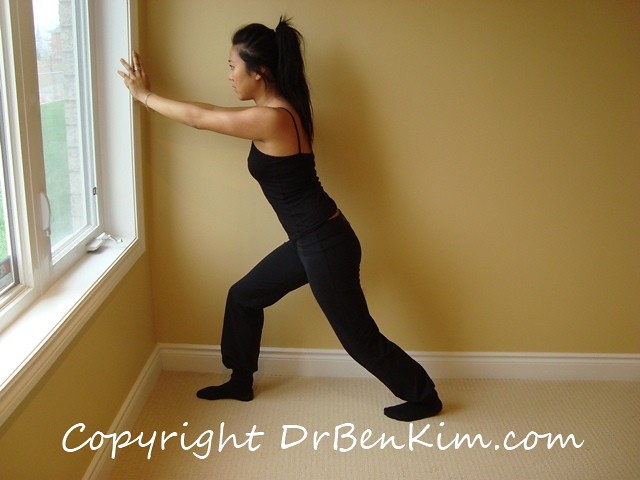You are here
Exercises for Knee Pain
When hamstrings and calves are short and hypertonic from lack of mindful use and stretching, their tendons can generate a low-grade backward pulling force on the tibia or femur, which predisposes the quadriceps and patellar tendon that runs along the anterior portion of the knee to injury. This is why regular stretching of your hamstrings, gastrocnemius, and soleus is essential to supporting healthy knee function.
Generally, the safest way to stretch your hamstrings is to focus on one leg at a time.
Unilateral Hamstring Stretch Using a Form of Warrior Pose:
In this photo, it's the hamstring muscle group of the grounded leg that is being stretched. If a hip problem or any other health challenge makes it difficult for you to perform this stretch, you can try stretching one side at a time while sitting on the ground, tucking the opposite foot in against the inner thigh of the leg you are stretching, then pulling gently on both sides of a towel that is hooked around the sole of the foot of your target leg.
Unilateral Hamstring Stretch while Seated:
Be sure to keep your lower back stable and straight, as there is no need to forward flex your lumbar spine to effectively stretch your hamstrings. In fact, if you keep your lower back slightly extended (super straight), you'll likely find that you won't have to bend too far forward from your waist to feel an excellent hamstring stretch.
To stretch your gastrocnemius (your upper calf region), stand near a wall, stabilize your upper body by pressing your hands against the wall, maintain balance of your lower extremities by keeping one leg up in front of you with your knee bent, and keeping your target leg back behind you, knee straight, and with your heel on the ground.
Here's a picture of what this looks like:
Keep your lower back and abdominal region strong and upright, and work to keep your back knee straight and your heel pressed into the ground. You should feel a nice stretch through your upper calf region and possibly even your Achilles tendon.
To stretch your soleus muscle, maintain this same position, but add a slight bend of your back knee while keeping your back heel on the ground or close to it. Bending your back knee just a smidge should transfer the stretch you feel from your upper calf to your lower calf.
Hold each stretch for about 30 seconds or as long as is comfortable, then switch to the other side. Repeat several times throughout the day for optimal results, or 3 to 5 sets on each leg once in the evening if you don't have time to do them throughout the day. As you would with all other stretches, be sure to maintain steady breathing and ease back if you feel pain.
Knee Pain Caused by Patellofemoral Tracking Dysfunction
Pain underneath and around the knee cap region can be caused by improper tracking of the knee cap - also called the patella - on the knee joint. The patella is embedded in a large tendon that represents the end of the quadriceps muscle, which runs along the front of the thigh to eventually insert into the main leg bone just below your knee joint. The quadriceps muscle is actually a group of four muscle bellies that share common origin and insertion points.
In a healthy leg, the four bellies of the quadriceps muscle pull on the patella in a way that allows the patella to move smoothly within a groove that exists along the front of the knee joint.
Sometimes, a wide hip angle and/or muscle imbalances in the hip and thigh can cause the quadriceps muscle to pull on the knee cap in a way that causes it to move out of line with respect to the knee joint. In this case, the knee cap has a tendency to move toward the outer half of the knee joint, which can create inflammation of the tissues between the back of the knee cap and the knee joint. In children and young adults, this condition is often called chondromalacia patella. In adults, it is usually called patellofemoral syndrome or patellofemoral tracking dysfunction.
Patellofemoral tracking dysfunction can be often be resolved with regular stretching of your quadriceps and hamstrings as shown in the modified Warrior Pose above, and with mindful training of the vastus medialis portion of your quadriceps, which is the inner-most belly of this large muscle group.
Sit or lie comfortably on your back and put a ball, foam roller, or rolled up towel under the knee that you want to work on - ideally, you want your knee to be 6 to 8 inches off the surface you are sitting on.
Keep your thigh still while doing this exercise. You should aim to keep the back of your knee steady on whatever you are using to prop your knee up - you shouldn't lift your knee off of it, nor should you allow your knee to sink too deeply into it.
With your thigh and knee in this position, rotate your hip slightly so that your foot points outward to whatever degree is comfortable, and slowly lift your foot up until your lower extremity is straight, from your hip to your foot. As you do this, you should feel your entire quadriceps muscle contract. The key is to focus on contracting the inner muscle belly of your quadriceps muscle - your vastus medialis.
Once your lower extremity is completely straight, slowly lower your foot, keeping your knee and thigh relatively still. Just before your heel hits the surface you are sitting on, start raising your foot again and repeat the process, gradually working your way up to 10 repetitions for each leg, 3 times a day.
Please remember to focus on squeezing the inner part of your quadriceps muscle throughout this exercise. When you first try this exercise, it's possible that you might only be able to do a few repetitions. Shaking and jiggling are quite common, especially if this movement is performed slowly. Most people find that their knees feel much stronger after about 3 months of consistently doing this exercise.
As mentioned in the video above, another common cause of knee pain is premature degenerative arthritis that can be the result of insufficient rotation of the tibia with flexion and extension of the knee joint. In a healthy knee joint, the tibia rotates internally about 15 to 20 degrees relative to the femur with knee flexion, and rotates externally by about the same amount relative to the femur when the knee is extended (straightened). This bit of rotation is needed to allow the menisci to properly shift to optimally protect the femoral condyles and superior articular surfaces of the tibia. For this rotation to occur, the ligamentous joint capsule that surrounds and provides stability to the knee joint needs to have a bit of healthy give, which is called joint play. Please be sure to watch the video above to see three simple movement patterns that you can do anywhere to help maintain healthy joint play in your knees, ankles, and hips.
There are other potential causes of knee pain and dysfunction, of course. The exercises described here and in the video above are typically helpful in restoring healthy knee function. But it's prudent to work with your health practitioner to rule out other causes of knee pain like excessive pronation during gait and metabolic arthritis. If you have any questions about your situation, you can write to me directly at benkim@drbenkim.com. I hope this information proves to be helpful.










